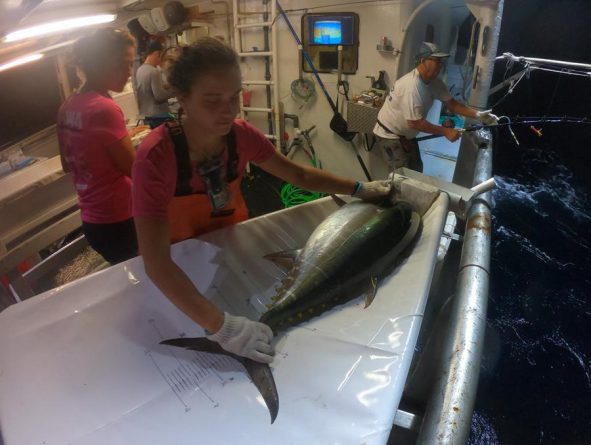Noumea, New Caledonia – The Pacific Community (SPC) has just completed a critical expedition to monitor the health of the world’s largest tuna fishery in the Western and Central Pacific. The success of the expedition was largely due to increased support provided by the fishing industry and technology sectors.
After 50 days in the waters of Kiribati and the high seas, the expedition tagged 6387 tuna, a record for the number of tags deployed on an SPC tagging cruise in the Central Pacific since the tagging programme began in 2006. The expedition also collected biological samples from over 500 fish and genetic samples from 800 specimens.
With most international tourism shut down due to Covid-19, many Pacific island countries and territories are more dependent than ever on revenue from the US$6bn tuna fishing industry. Pamela Maru, Secretary of the Cook Islands’, Ministry of Marine Resources, commented “Continued investment and work through the tuna tagging programme is critical for the Pacific region so we can then learn how to approach our fisheries management strategies and provide information to our industry about how they might have to organise their operations”.
SPC has now tagged over 450,000 tuna since 2006, generating the most comprehensive tag data set for tuna science and management in the world. The tagging information is vital to show how fishing activities and climate change affect the health of fisheries.
Pamela Maru highlighted that “SPC’s tagging programme provides Pacific countries with an invaluable scientific dataset to support the sustainable management of the world’s largest tuna fishery. The interest for us here in the Pacific is ensuring that we have sustainable stocks so that in the future we can continue to benefit from those resources,” she mentioned.
This year the tagging expedition boosted its access to schools of bigeye and yellowfin tuna through increased cooperation with the region’s tuna industry. Dr Simon Nicol, SPC’s Principal Fisheries Scientist, explained how this cooperation with the fishing sector has enabled the 2020 tagging expedition to be far more efficient.
“This is largely due to the excellent industry cooperation for this cruise as they have provided daily real-time positions of their fish aggregating devices (FADs) where SPC is tagging with associated tuna abundance and oceanographic condition information” stated Dr Nicol.
William Gibbons-Fly, the Director of the American Tuna Boat Association has a membership that consists of 24 large tuna purse seine vessels that operate in the Pacific Ocean. He says many modern FADs are attached to high-tech buoys with solar-powered electronics and echo sounders that can measure the amount of fish gathered around a particular FAD at any one time.
“Most of the time our vessels are very reluctant to share this information in real-time, but during the 3-month FAD closure between July to September, this information becomes very valuable to the scientists. Because of our relationship with SPC and the importance of their stock assessments, we’re able to share this information in real-time with the tagging expedition,” he explained.
Kathryn Gavira O’Neill is a marine biologist from the Spain-based company Satlink, which specializes in using satellite communications, used to improve the management of commercial fisheries around the world. She acknowledged the SPC’ tagging programme to contribute to one of the world’s best examples of sustainable fisheries management.
“It would be great to see this cross-sectoral approach, involving industry, tech providers and the interests of the Pacific Island Countries and Territories, replicated in other oceans around the world,” she stated.



